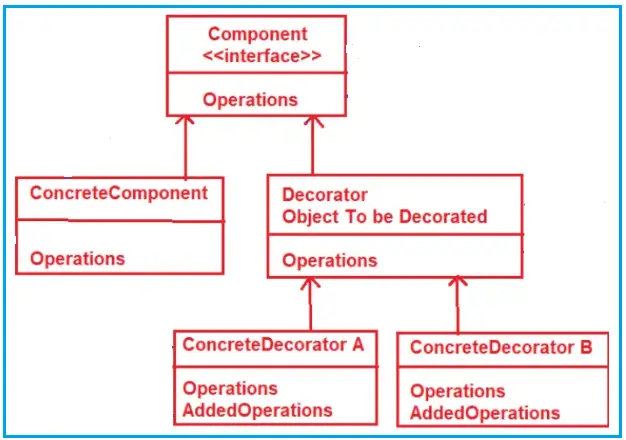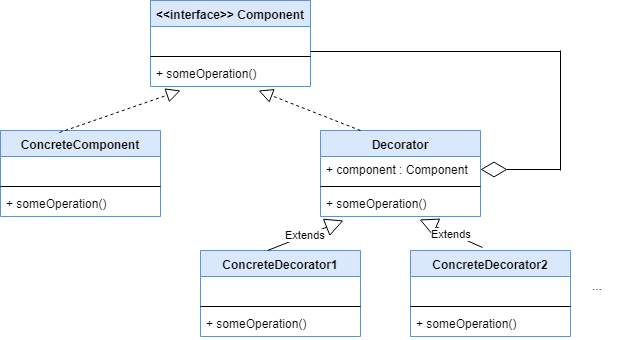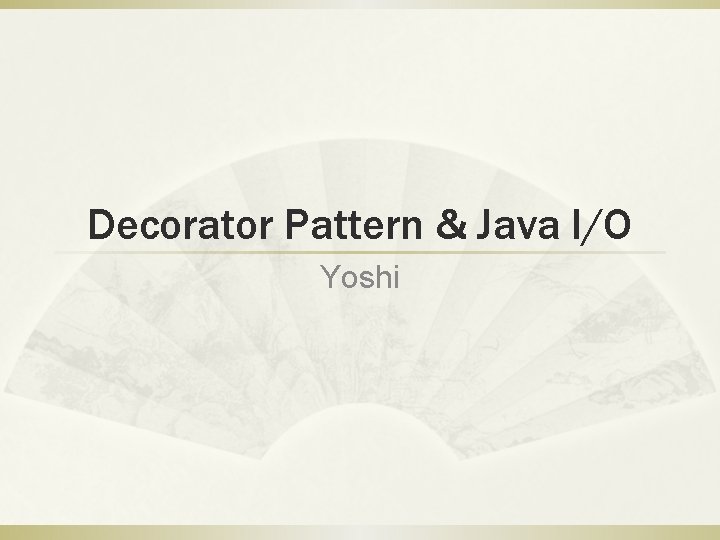Using Decorator Pattern in Java: When and Why

In object-oriented programming, especially when developing in Java, we often run into scenarios where adding new behaviors or responsibilities to an object dynamically at runtime is necessary. This requirement can lead developers to refactor code or even redesign classes. However, Java's Decorator pattern offers a more elegant solution by allowing us to wrap an object to enhance its functionality without altering its underlying structure.
What is the Decorator Pattern?

The Decorator pattern, a fundamental design pattern in Java, falls under the structural category as per the Gang of Four (GoF) classification. It’s an alternative to subclassing for extending functionality. Here’s how it fundamentally operates:
- Composition over inheritance: Instead of subclassing, we use object composition to wrap one object with another to add additional responsibilities.
- Decorators can be stacked: Multiple decorators can be stacked on top of one another, allowing for flexible customization.
- Dynamic behavior modification: It enables runtime behavior modification, which is not possible with traditional inheritance where changes are compiled into the class structure.

When to Use the Decorator Pattern?

The Decorator pattern is particularly useful in situations where:
- You need to add responsibilities to individual objects dynamically and transparently.
- You need to extend an object’s functionality without using subclassing for each extension.
- When a complex application of inheritance is undesirable or would lead to a bloated class hierarchy.
- The need to wrap objects in order to add functionality is common within your application.
How Does it Work?

The implementation of the Decorator pattern involves several key components:
- Component: The core interface or abstract class defining the common interface for both the concrete object and the decorators.
- Concrete Component: The class being wrapped or decorated.
- Decorator: The abstract class that wraps the component. It has a reference to a Component and implements the interface defined in the Component.
- Concrete Decorators: Classes that extend the Decorator, adding or overriding methods to add responsibilities.
Here’s how the classes might look:
| Class | Role |
|---|---|
| Interface | Defines the interface for objects that can have responsibilities added to them dynamically |
| ConcreteComponent | Defines an object to which additional responsibilities can be attached |
| Decorator | Maintains a reference to a Component object and defines an interface that conforms to the Component’s interface |
| ConcreteDecorator | Adds responsibilities to the component |

🔍 Note: Remember that decorators and components have the same supertype, making them interchangeable at runtime.
A Practical Example of Decorator Pattern

Let’s delve into an example to illustrate the Decorator pattern:
public interface DataSource {
void writeData(String data);
String readData();
}
class FileDataSource implements DataSource {
private String name;
public FileDataSource(String name) {
this.name = name;
}
@Override
public void writeData(String data) {
// Write data to the file
}
@Override
public String readData() {
// Read data from the file
return null;
}
}
abstract class DataSourceDecorator implements DataSource {
protected DataSource wrappee;
public DataSourceDecorator(DataSource source) {
this.wrappee = source;
}
@Override
public void writeData(String data) {
this.wrappee.writeData(data);
}
@Override
public String readData() {
return this.wrappee.readData();
}
}
class CompressionDecorator extends DataSourceDecorator {
public CompressionDecorator(DataSource source) {
super(source);
}
@Override
public void writeData(String data) {
// Compress data
super.writeData(data);
}
@Override
public String readData() {
String data = super.readData();
// Decompress data
return data;
}
}
class EncryptionDecorator extends DataSourceDecorator {
public EncryptionDecorator(DataSource source) {
super(source);
}
@Override
public void writeData(String data) {
// Encrypt data
super.writeData(data);
}
@Override
public String readData() {
String data = super.readData();
// Decrypt data
return data;
}
}
// Usage
public class DecoratorExample {
public static void main(String[] args) {
String input = "Hello, World!";
DataSourceDecorator encoded = new CompressionDecorator(new EncryptionDecorator(new FileDataSource("data")));
encoded.writeData(input);
DataSource file = encoded;
System.out.println(file.readData());
}
}
This example shows how we can add functionalities like compression and encryption to a file data source without changing the existing FileDataSource class.
Benefits of Using the Decorator Pattern

- Flexibility: Enhances an object’s functionality at runtime, allowing for on-the-fly configuration.
- Single Responsibility Principle: Supports this principle by allowing one class to handle one responsibility, keeping classes focused and simple.
- Extensibility: New decorators can be added to introduce additional behaviors without modifying existing classes.
- Open-Closed Principle: Classes can be extended without modification, adhering to the Open-Closed Principle.
- Loose Coupling: Since decorators can be added or removed dynamically, systems become more flexible and loosely coupled.
Considerations and Potential Drawbacks

- Complexity: Using multiple decorators can introduce additional complexity in understanding the flow of control.
- Potential Overuse: Overuse of decorators can lead to cluttered code, making it hard to keep track of what each decorator does.
- Performance Overhead: Creating new objects for each decorator can result in some overhead, especially if it happens frequently.
🔍 Note: Use this pattern judiciously. The power of decorators lies in their ability to enhance functionality, but an overzealous approach can lead to unnecessary complexity.
By mastering the Decorator pattern, developers can significantly improve the flexibility of their Java applications, allowing for easy addition of new features or modifications without the need to alter or subclass existing code extensively. This pattern proves invaluable in scenarios where runtime customization is essential, keeping the codebase clean, manageable, and aligned with the principles of good design.
What is the primary advantage of the Decorator pattern?

+
The primary advantage of the Decorator pattern is the ability to add new functionalities to an object at runtime without altering its structure, which promotes code reuse and follows the Single Responsibility Principle.
When should one not use the Decorator pattern?

+
The Decorator pattern should be avoided when the functionality to be added is too complex or when a simpler inheritance strategy would suffice. It might also not be the best choice for situations where a client needs to know about all the decorators applied to an object.
Can I stack decorators?

+
Yes, decorators can be stacked one on top of the other, allowing for multiple behaviors to be added to an object at runtime, making it highly flexible.